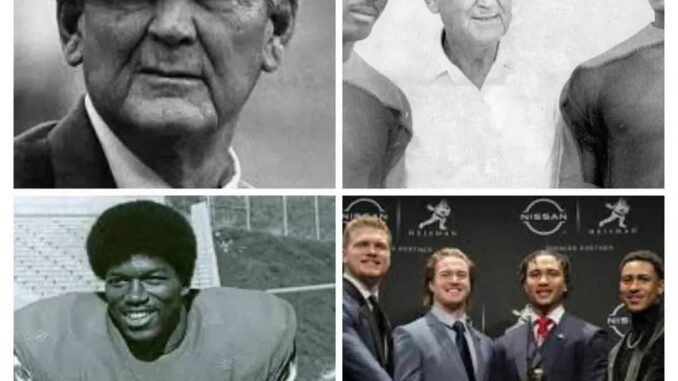
Blood on the Gridiron: Unveiling the Dark Origins of Alabama’s Football Dynasty—A Deep Look into How Segregation, Silence, and Southern Pride Shaped One of the Nation’s Greatest College Football Empires
In the world of college football, few names carry the weight, tradition, and triumph of the University of Alabama Crimson Tide. With 18 claimed national championships, dozens of conference titles, and an army of Heisman winners, NFL legends, and passionate fans, Alabama’s football program is often portrayed as a shining beacon of athletic achievement. But behind the roaring crowds of Bryant-Denny Stadium and the glossy pages of championship history lies a story less celebrated—a story etched in the legacy of segregation, systemic racism, cultural silence, and the Southern pride that once refused to yield.
This is the uncomfortable, often overlooked history of how Alabama’s football empire was built—not just on talent, but on exclusion.
The Rise of a Dynasty in the Jim Crow South
When the Crimson Tide began establishing its football dominance in the early-to-mid 20th century, the South was deep in the grips of Jim Crow laws. Segregation was legal and enforced in every institution, including sports. From 1892, when Alabama played its first game, until the late 1960s, the roster was exclusively white—by law, by policy, and by unwritten cultural code.
Under the legendary leadership of Paul “Bear” Bryant, who became head coach in 1958, Alabama soared to national prominence. Bryant’s teams were disciplined, tough, and ruthlessly effective—but they were also all white, even as schools across the country began integrating their athletic programs.
While Bryant is widely celebrated as one of the greatest coaches in college football history, some historians argue that his legacy is more complicated. Though many claim he was personally in favor of integration, he made few public statements condemning segregation or actively recruiting Black athletes until well into the Civil Rights Movement.
> “Bear Bryant was a product of his time—and so was Alabama football,” says Dr. Lacy Williams, a historian at the University of Georgia specializing in Southern sports history. “The school’s success in the 1950s and ’60s happened while actively benefiting from a segregated system that denied opportunities to generations of Black athletes.”
The Turning Point: Integration in the Shadow of Protest
It wasn’t until 1971—more than a decade after other programs like UCLA and Michigan had begun recruiting Black players—that Alabama signed its first African American scholarship athlete: Wilbur Jackson, a talented running back from Ozark, Alabama. That same year, John Mitchell, a junior college transfer, became the first Black player to actually take the field for the Crimson Tide.
But this shift didn’t occur in a vacuum. The Civil Rights Movement had reached Alabama’s doorstep in the form of marches, national scrutiny, and protests. From Selma to Montgomery, the state had become a flashpoint in the fight for racial equality. It became increasingly untenable for Alabama’s football program to ignore integration, especially as other SEC teams—such as Kentucky and Tennessee—began recruiting Black athletes and widening the competitive gap.
> “It wasn’t just morality—it was survival,” says Williams. “They could no longer win at the highest level without access to the nation’s best athletes, many of whom were Black.”
Cultural Silence and the Sanitization of History
Despite the monumental contributions of Black athletes to Alabama’s football legacy in the decades that followed, the program has often been reluctant to fully confront its segregated past. Bryant’s image remains central to the school’s branding, and while some ceremonies have honored trailblazers like Jackson and Mitchell, deeper institutional reflection has been minimal.
Critics argue that the myth of Alabama football has been preserved through selective memory, where uncomfortable truths are smoothed over in favor of a more palatable narrative of unity and greatness.
> “There’s blood on the gridiron, metaphorically speaking,” said civil rights activist and former sportswriter Melvin Thomas. “Black athletes helped build this empire—but they weren’t allowed to from the beginning. That matters. It has to be acknowledged.”
A New Era, A Lingering Legacy
Today, Alabama’s team is a far cry from its segregated roots. The roster is majority-Black, and athletes are more empowered than ever to speak out on social justice issues. Former head coach Nick Saban even marched with his players in 2020 following the murder of George Floyd—a scene unthinkable in Bear Bryant’s time.
Yet, the journey from exclusion to inclusion remains part of the Crimson Tide’s DNA. To ignore it is to erase the struggle that made progress possible.
> “We’re proud of what Alabama football is today,” says Dr. Williams. “But we must also remember what it was. The silence, the segregation, and the Southern pride that kept so many out—that’s part of the story too.”
As college football continues to evolve, so must its most legendary programs. And for Alabama, greatness cannot just be measured in trophies—but in truth.
Leave a Reply